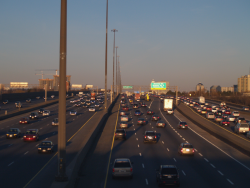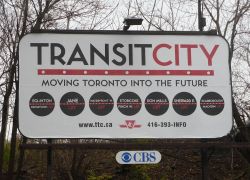We probably couldn't have planned a better release date for Driving Down Carbon, a report we published today looking at the impacts of how Ontarians get around. It coincides with recent findings that show gridlock in Toronto is among the worst for big cities. And it's necessary to give context to recent transit cuts, new vehicle emissions standards and climate commitments.
Frustrated drivers
Last week, a Board of Trade report found the Greater Toronto Area (GTA) had the longest commute times of 19 major cities, including New York and Los Angeles. An OECD report from December confirms those findings, ranking the GTA worst for traffic congestion, which costs the city $3.3 billion per year. The OECD points out that despite these costs, the GTA is the only city of its size without road tolls or congestion charges to offset the ongoing expenses.
Of course, road tolls are considered a political death trap, potentially angering some voters. The current mayoral race is already seeing some candidates weigh in on the controversial subject.
Rather than narrow in on a one-policy solution and thus polarize the debate, our report suggests a menu of funding options, all of which should be on the table, including tolls.
Budget priorities drive by transit
Toronto has big city problems and we need big city solutions, but the rubber hits the road at the provincial level.
Last week, while budget cuts to transit were occurring at Queens Park, quite the opposite was taking place in Quebec. The provincial government announced increases to both provincial and regional (Metro Montreal) gas taxes to fund transit. The tax, unlike Ontario's HST, has a clear and focused purpose: to fund public transit. The way it's designed, the tax will discourage personal vehicle use and encourage public transit ridership, paving the way for the province to meet its emissions reduction targets.
If that wasn't enough, Quebec is also introducing a program to manufacture electric buses in the province which will also reduce emissions and create jobs. Meanwhile, Ontario's parked its bus replacement program.
Vehicle emissions regulations on the right track
While budgets have been slashed, policies have at least been beefed up a bit. The Canada-U.S. joint regulations of vehicle efficiency and emissions also hit the news last week.
The regulations will increase vehicle emissions standards for Ontario's vehicles, but they won't actually begin to reduce emissions until 2012.
Making vehicles cleaner is good step, but vehicle standards alone will not solve the problem of growing greenhouse gas emissions. It may reduce emissions on a per vehicle basis, but the Greater Golden Horseshoe area alone expects four million new people and 1.6 million more cars on the roads over the next 20 to 25 years.
Unless strong policies are put in place to reduce the amount of time Ontarians spend behind the wheel, emissions from personal transportation will continue to go up. Simply put, the sheer volume of vehicles on the road will drive emissions up.
That's why prioritizing public transit and smart growth is so important.Municipal, provincial and federal cooperation is crucial to realizing either of these goals.
Toronto clearly has green dreams with its Transit City plans, but those dreams won't become a reality without the provincial and federal funds to back them up.
Similarly, Toronto can't grow in a smart way if provincial planning policy that enables suburban sprawl and continued highway development.
In many ways, the city of Toronto is doing its best within a gridlock not of its own design.
Climate commitments demand transportation focus
The province's first annual climate report measures progress to meeting greenhouse gas emission reduction goals. To its credit, the province is monitoring and demonstrating accountability for its own progress.
The report found that current provincial policies will get us about 56% of the way there. Most of this will come from the phase out of coal-fired power plants and Ontario's green energy policies.
But its transportation that's stalling progress. The sector, which accounts for 31% of the province's GHG pollutions, is the largest and fastest growing source of greenhouse gas emissions in the province. With that in mind, this is also the sector that represents the greatest opportunity to reduce emissions, provided the right mix of policies and funding is introduced.
Driving Down Carbon makes recommendations for improved and new policies for the personal transportation in Ontario that could steer us in the right direction to meet our 2020 emission reductions goals.
Cherise Burda was Ontario director at the Pembina Institute until 2015.



